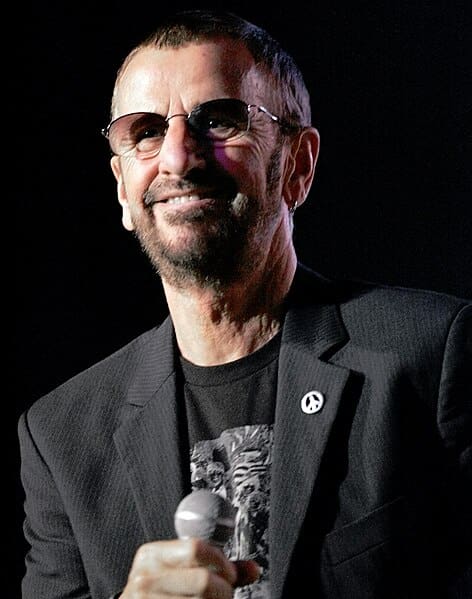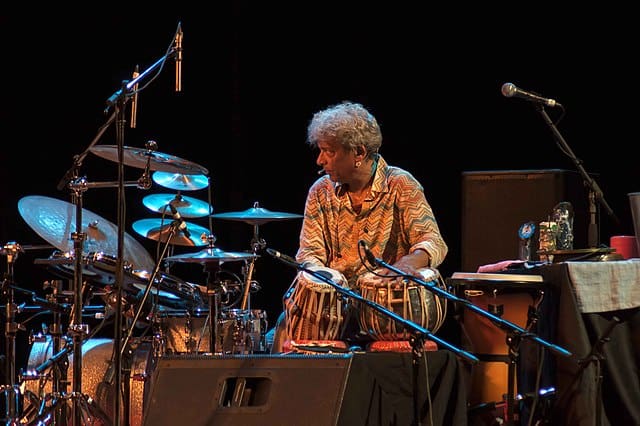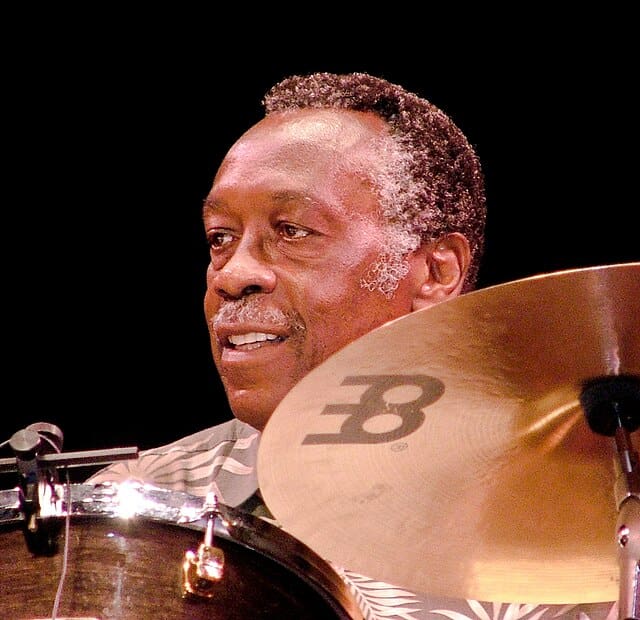20 Iconic Percussionists Who Shaped Music History
From the pulsating beats of jazz to the electrifying rhythms of rock, percussionists have played a pivotal role in shaping the landscape of music history. Their mastery of rhythm, technique, and innovation has transformed the way we listen to and experience music, leaving an indelible mark on genres as diverse as jazz, rock, funk, and beyond.
Embark on a captivating journey through the annals of music, where the virtuosity of percussionists takes centre stage. Discover the groundbreaking techniques of Buddy Rich, whose explosive drumming redefined the role of the jazz drummer. Immerse yourself in the fusion era, where Tony Williams’s groundbreaking drumming seamlessly blended jazz, rock, and funk. In this article, we highlight 20 iconic Percussionists Who Shaped Music History
1. Buddy Rich
Buddy Rich was an American jazz drummer, songwriter, conductor, and bandleader. He is considered one of the most influential drummers of all time. Rich was known for his virtuoso technique, power, and speed. He was an advocate of the traditional grip, though he occasionally used a matched grip when playing the toms. Despite his commercial success and musical talent, Rich never learned how to read sheet music, preferring to listen to drum parts and play them from memory.
Rich was born and raised in Brooklyn, New York, United States. He discovered his affinity for jazz music at a young age and began drumming at the age of two. He began playing jazz in 1937, working with acts such as Bunny Berigan, Artie Shaw, Tommy Dorsey, Count Basie, and Harry James. From 1942 to 1944, Rich served in the U.S. Marines. From 1945 to 1948, he led the Buddy Rich Orchestra. In 1966, he recorded a big-band-style arrangement of songs from West Side Story. He found lasting success in 1966 with the formation of the Buddy Rich Big Band.
2. Ringo Starr

Eva Rinaldi from Sydney, Australia, CC BY-SA 2.0, via Wikimedia Commons
Ringo Starr known professionally as Ringo Starr, is an English musician, songwriter and actor who achieved international fame as the drummer for the Beatles. Starr’s playing style, which emphasised feel over technical virtuosity, influenced many drummers to reconsider their playing from a compositional perspective. He also influenced various modern drumming techniques, such as the matched grip, tuning the drums lower, and using muffling devices on tonal rings.
In his opinion, his finest recorded performance was on the Beatles’ Rain. In 1999, he was inducted into the Modern Drummer Hall of Fame. In 2011, Rolling Stone readers named him the fifth-greatest drummer of all time. He was inducted twice into the Rock and Roll Hall of Fame, as a Beatle in 1988 and as a solo artist in 2015, and appointed a Knight Bachelor in the 2018 New Year Honours for services to music. In 2020, he was cited as the wealthiest drummer in the world, with a net worth of $350 million.
3. Ginger Bake
Ginger Bake was an English drummer. His work in the 1960s and 1970s earned him the reputation of rock’s first superstar drummer, for a style that melded jazz and African rhythms and pioneered both jazz fusion and world music.
Baker’s drumming is regarded for its style, showmanship, and use of two bass drums instead of the conventional single one, after the manner of the jazz drummer Louie Bellson. In his early days, he performed lengthy drum solos, most notably in the Cream song Toad, one of the earliest recorded examples in rock music. Baker was an inductee of the Rock and Roll Hall of Fame as a member of Cream in 1993, of the Modern Drummer Hall of Fame in 2008, and of the Classic Drummer Hall of Fame in 2016.
4. Evelyn Glennie

No machine-readable author provided. Nomo assumed (based on copyright claims)., CC BY-SA 2.5, via Wikimedia Commons
Evelyn Glennie is a Scottish percussionist. Glennie tours all over the world performing as a soloist with a wide variety of orchestras and eclectic musicians. She conducts master classes, and consultations and engages in motivational speaking. She is a leading commissioner of new works for solo percussion.
Glennie performed at the Opening Ceremony of the Olympic Games in London 2012, leading a thousand drummers in the opening piece of music And I Will Kiss, and also playing the Glennie Concert Aluphone in Caliban’s Dream during the ceremony for lighting the Olympic cauldron. She has been awarded 29 honorary doctorates from universities in the United Kingdom, most recently in 2023, a Doctor of Music from the University of St Andrews, and the Officer of the Most Excellent Order of the British Empire in 1993.
5. John Bonham
John Bonham was an English musician who was the drummer of the rock band Led Zeppelin. Noted for his speed, power, fast single-footed kick drumming, distinctive sound, and feel for groove, he is regarded as one of the greatest and most influential drummers in music history.
While he was primarily known for his hard-rock style during his lifetime, his reputation as a drummer has grown beyond that genre following his death. With the band, Led Zeppelin, Bonham mostly showcased a hard-hitting hard rock style but also handled funk and Latin-influenced grooves in later releases. He was posthumously inducted into the Rock and Roll Hall of Fame in 1995 as a member of Led Zeppelin. In 2016, Rolling Stone named him the greatest drummer of all time.
6. Tito Puente

Kingkongphoto & www.celebrity-photos.com from Laurel Maryland, USA, CC BY-SA 2.0, via Wikimedia Commons
Tito Puente was an American musician. He composed dance-oriented mambo and Latin jazz music. He switched to percussion by the age of 10, drawing influence from jazz drummer Gene Krupa. When the drummer in Machito’s band was drafted into the army, Puente subsequently took his place.
During the 1950s, Puente was at the height of his popularity and helped to bring Cuban and Caribbean sounds like mambo, son, and cha-cha-chá, to mainstream audiences. His album Dance Mania was released in 1958.
7. Keith Moon
Keith Moon was an English musician who was the drummer for the rock band the Who. Moon grew up in Wembley and took up the drums during the early 1960s. After playing with a local band, the Beachcombers, he joined the Who in 1964 before they recorded their first single. Moon was recognised for his drumming style, which emphasised tom-toms, cymbal crashes, and drum fills. Throughout his tenure with the Who, his drum kit steadily grew in size, and along with Ginger Baker, he has been credited as one of the earliest rock drummers to regularly employ double bass drums in his setup.
Moon’s drumming continues to be praised by critics and musicians.
He was posthumously inducted into the Modern Drummer Hall of Fame in 1982, becoming the second rock drummer to be chosen, and in 2011 he was voted the second-greatest drummer in history by a Rolling Stone readers’ poll. Moon was inducted into the Rock and Roll Hall of Fame in 1990 as a member of the Who.
8. Airto Moreira

Daniel Shen Taipei, Taiwan, CC BY-SA 2.0, via Wikimedia Commons
Airto Moreira is a Brazilian jazz drummer and percussionist. Coming to prominence in the late 1960s as a member of the Brazilian ensemble Quarteto Novo, he moved to the United States and worked in jazz fusion with Miles Davis and Return to Forever.
After moving to the US, Moreira studied with Moacir Santos in Los Angeles. At this time Davis was experimenting with electronic instruments and rock and funk rhythms, a form which would soon come to be called jazz fusion.
9. Stewart Copeland
Stewart Copeland is an American musician and composer. He is best known for his work as the drummer of the English rock band The Police. Before playing with the Police, he played drums with the English rock band Curved Air from 1975 to 1976.
According to MusicRadar, Copeland’s distinctive drum sound and uniqueness of style have made him one of the most popular drummers to ever get behind a drumset. He was ranked the 10th best drummer of all time by Rolling Stone in 2016.
10. Max Roach

William P. Gottlieb, Public domain, via Wikimedia Commons
Max Roach was an American jazz drummer and composer. A pioneer of bebop, he worked in many other styles of music and is generally considered one of the most important drummers in history. He worked with many famous jazz musicians.
In the mid-1950s, Roach co-led a pioneering quintet along with trumpeter Clifford Brown. In 1970, he founded the percussion ensemble M’Boom. He made numerous musical statements relating to the civil rights movement.
11. Karen Carpenter
Karen Carpenter was an American singer and drummer who formed half of the highly successful duo the Carpenters with her older brother Richard. She began to study the drums in high school and joined the Long Beach State choir after graduating.
After several years of touring and recording, the Carpenters were signed to A&M Records in 1969, achieving enormous commercial and critical success throughout the 1970s. Initially, Carpenter was the band’s full-time drummer, but she gradually took the role of frontwoman as her drumming was reduced to a handful of live showcases or tracks on albums.
12. Sheila E.

Justin Higuchi from Los Angeles, CA, USA, CC BY 2.0, via Wikimedia Commons
Sheila E. is an American singer and drummer. She began her career in the mid-1970s as a percussionist for the George Duke Band. After separating from the band in 1983, Sheila began a solo career, starting with the release of her debut album in 1984, which included her biggest hit song, The Glamorous Life. She also saw a hit with the single A Love Bizarre. She is sometimes referred to as the Queen of Percussion.
13. Nana Vasconcelos
Nana Vasconcelos was a Brazilian percussionist, vocalist and berimbau player, notable for his work as a solo artist on over two dozen albums. Beginning in 1967 he joined many artists’ works as a percussionist. Among his many collaborations, he contributed to four Jon Hassell albums from 1976 to 1980, including Possible Musics by Brian Eno and Hassell, and later to several Pat Metheny Group works and Jan Garbarek concerts from the early 1980s to early 1990s.
Vasconcelos was awarded the Best Percussionist Of The Year by the Down Beat Critics Poll for seven consecutive years, from 1984 to 1990. He was also honoured with eight Grammy Awards. Between 1984 and 1989, he was the Honorary President of the first samba school in the UK, the London School of Samba.
14. Trilok Gurtu

Frolzart, CC BY-SA 4.0, via Wikimedia Commons
Trilok Gurtu is an Indian percussionist and composer whose work has blended the music of India with jazz fusion and world music. Gurtu was born to Hindu Brahmin parents in Mumbai, India. Gurtu began playing a western drum kit in the 1970s and developed an interest in jazz. Some of the unusual aspects of Gurtu’s drum playing include playing without a drum stool, in a half-kneeling position on the floor, and the use of an unconventional kick drum that resembles a large drum head with a kick-pedal, and a mix of tablas and western drums.
Trilok Gurtu is universally acknowledged as one of the most innovative and groundbreaking percussionists around; integrating swords, buckets and other non-conventional elements into his sound. Gurtu’s unique percussion signature involves dipping cymbals and strings of shells into a bucket of water to create a shimmering effect.
15. Zakir Hussain
Zakir Hussain is an Indian tabla player, composer and percussionist. Mickey Hart of the Grateful Dead, who had known Hussain since the 1960s, invited him to create the special album Planet Drum, featuring drummers from different parts of the world. The Global Drum Project album and tour brought Mickey Hart, Hussain, Sikiru Adepoju, and Giovanni Hidalgo together again in a reunion sparked by the 15th anniversary of the Planet Drum album.
The album Global Drum Project won the Grammy Award for Best Contemporary World Music Album at the 51st Grammy Awards Ceremony held on 8 February 2009. In 2016, Hussain was amongst many musicians invited by President Obama to the International Jazz Day 2016 All-Star Global Concert at the White House.
16. Clyde Stubblefield

Paul VanDerWerf, CC BY 2.0, via Wikimedia Commons
Clyde Stubblefield was an American drummer best known for his work with James Brown, with whom he recorded and toured for six years between 1965 to 1970. His syncopated drum patterns on Brown’s recordings are considered funk standards. Samples of his drum performances, particularly his break in the 1970 track Funky Drummer were heavily used in hip-hop music beginning in the 1980s, although Stubblefield frequently received no credit.
A self-taught musician, Stubblefield was influenced by the sound of industrial rhythms he heard in factories and trains. He began playing with local groups in his native Tennessee and later moved to Georgia, where he played with musicians such as Eddie Kirkland and Otis Redding in the early 1960s before joining Brown’s band. He has been named among the great drummers of all time by various publications.
17. Harvey Mason Sr.
Harvey Mason Sr. is an American jazz drummer, record producer, and member of the band Fourplay. He was the original drummer for Herbie Hancock’s band The Headhunters. Mason endorses Canopus drums, Murat Diril cymbals, Remo drumheads, DW pedals, and Vic Firth drumsticks. Mason has his own Vic Firth Harvey Mason signature drumstick and Vic Firth Harvey Mason Chameleon signature drumstick.
Mason, who attended Berklee in the 1960s, received an Honorary Doctorate at Berklee’s 2015 Commencement Ceremony for his achievement and influence in music and for his enduring contributions to American and international culture.
18. Bernard Purdie

The Big Joe Henry Show, CC BY 3.0, via Wikimedia Commons
Bernard Purdie is an American drummer, and an influential R&B, soul and funk musician. He is known for his precise musical time-keeping and his signature use of triplets against a half-time backbeat: the Purdie Shuffle. He was inducted into the Modern Drummer Hall of Fame in 2013.
Purdie is known as a groove drummer with immaculate timing who makes use of precision half notes, backbeats, and grooves. He created the now well-known drum pattern Purdie Half-Time Shuffle which is a blues shuffle variation with the addition of syncopated ghost notes on the snare drum. Purdie plays the shuffle on Steely Dan’s Babylon Sisters and Home At Last.
19. Steve Gadd
Steve Gadd is an American drummer, percussionist, and session musician. Gadd is one of the best-known and highly regarded session and studio drummers in the industry, recognized by his induction into the Modern Drummer Hall of Fame in 1984. Gadd grew up in Irondequoit, New York. He started playing the drums at a very early age.
In 1981, he played drums and percussion for Simon and Garfunkel’s Concert in Central Park. Gadd has written a book about the rudiments of drumming entitled Gaddiments, which was released on Hudson Music in 2021.
20. Tony Williams

Brianmcmillen, CC BY-SA 4.0, via Wikimedia Commons
Tony Williams was an American jazz drummer. Williams first gained fame as a member of Miles Davis‘ Second Great Quintet and later pioneered jazz fusion with Davis’ group and his own combo, the Tony Williams Lifetime.
In 1970, music critic Robert Christgau described him as probably the best drummer in the world. Williams was inducted into the Modern Drummer Hall of Fame in 1986.
This list spans various genres and eras, showcasing the diversity and impact of percussionists in the world of music. These iconic percussionists, through their mastery of rhythm, technique, and innovation, have left an indelible mark on music history. Their contributions have enriched the world of music, inspiring generations of musicians and shaping the sounds we hear today.
Planning a trip to Paris ? Get ready !
These are Amazon’s best-selling travel products that you may need for coming to Paris.
Bookstore
- The best travel book : Rick Steves – Paris 2023 – Learn more here
- Fodor’s Paris 2024 – Learn more here
Travel Gear
- Venture Pal Lightweight Backpack – Learn more here
- Samsonite Winfield 2 28″ Luggage – Learn more here
- Swig Savvy’s Stainless Steel Insulated Water Bottle – Learn more here
Check Amazon’s best-seller list for the most popular travel accessories. We sometimes read this list just to find out what new travel products people are buying.









